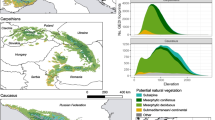Abstract
The lack of scientific baseline information hinders appropriate design and management of protected areas. To illustrate the value of science to management, we consider five scenarios for the 202.0 km² Puerto Princesa Subterranean River National Park, Philippines: (1) closure to human activities, (2) and (3) two levels of increase in unplanned human activities, (4) creation of a forest corridor and (5) additional allocation of land for permanent or shifting agriculture. We then use habitat-specific bird density estimates to simulate the net effect of each scenario on 18 focal bird populations. Closure has significant benefits—populations of five species are predicted to increase by >50 % and nine by >25 %, but two secondary forest flycatchers, including the endemic and ‘Vulnerable’ Palawan flycatcher, decline dramatically, while the creation of a 4.0 km² forest corridor yields average increases across species of 2 ± 4 % (SD). In contrast, heavier unplanned park usage produces declines in all but a few species, while the negative effects of an extra 2.0 km² of shifting cultivation are 3–5 times higher than for a similar area of permanent agriculture and affect species whose densities are highest in primary habitats. Relatively small changes within the park, especially those associated with agricultural expansion, has serious predicted implications for local bird populations. Our models do not take into account the full complexities of bird ecology at a site, but they do provide park managers with an evidence base from which to make better decisions relating to biodiversity conservation obligations which their parks are intended to meet.

Similar content being viewed by others
References
Biodiversity Indicators Partnership (2010) http://www.bipindicators.net/pacoverage. Accessed 7 Sept 2011
BirdLife International (2004) Important bird areas in Asia: key sites for conservation. BirdLife International, Cambridge
Brook BW, Sodhi NS, Ng PKL (2003) Catastrophic extinctions follow deforestation in Singapore. Nature 424:420–423
Buckland ST, Anderson DR, Burnham KP, Laake JL, Borchers DL, Thomas L (2001) Introduction to distance sampling: estimating abundance of biological populations. Oxford University Press, Oxford
Caro TM (2003) Umbrella species: critique and lessons from East Africa. Anim Conserv 6:171–181
Carroll C, Noss RF, Paquet PC (2001) Carnivores as focal species for conservation planning in the Rocky Mountain region. Ecol Appl 11:961–980
Carwardine J, Rochester WA, Richardson KS, Williams KJ, Pressey RL, Possingham HP (2007) Conservation planning with irreplaceability: does the method matter? Biodivers Conserv 16:245–258
Conservation International (2004) Surublien: strategies to conserve Palawan’s biodiversity. Provincial Government of Palawan, Palawan Council for Sustainable Development Staff, Department of Environment and Natural Resources-MIMAROPA Region IV, Palawan NGO Network, Inc., Conservation International-Philippines, Puerto Princesa City, p 124
Convention on Biological Diversity (2011) http://www.cbd.int/sp/targets/rationale/target-11/. Accessed 7 Sept 2011
Danielsen F, Burgess ND, Balmford A (2005) Monitoring matters: examining the potential of locally-based approaches. Biodivers Conserv 14:2507–2542
DENR-NAMRIA and JAFTA (2000) Land Cover Statistics 1993–2000: Palawan Forest Cover Map. Department of Environment and Natural Resources/National Mapping and Resource Authority, and Japan Forest Technology Association. DENR-FMB, Quezon City, Philippines
Dickinson EC, Kennedy RS, Parkes KC (1991) The birds of the Philippines: an annotated check-list. British Ornithologists' Union Check-list number 12. British Ornithologists' Union, London
Dressler WH (2006) Co-opting conservation: migrant resource control and access to national park management in the Philippine uplands. Dev Chang 37:401–426
Dressler WH, Kull CA, Meredith TC (2006) The politics of decentralizing national parks management in the Philippines. Political Geogr 25:789–816
Gaston KJ, Jackson SF, Cantú-Salazar L, Cruz-Piñón G (2008) The ecological performance of protected areas. Ann Rev Ecol Evol Syst 39:93–113
Goodale UM, Lanfer AG, Stern MJ, Margoluis C, Fladeland M (eds) (2003) Transboundary protected areas: the viability of regional conservation strategies. Haworth Press Inc, West Hazleton
Hayes TM (2006) Parks, people, and forest protection: an institutional assessment of the effectiveness of protected areas. World Dev 34:2064–2075
Hockings M, Stolton S, Leverington F, Dudley N, Courrau J (2006) Evaluating effectiveness: a framework for assessing management effectiveness of protected areas, 2nd edn. IUCN, Gland/Cambridge
Jim CY, Xu SSW (2004) Recent protected-area designation in China: an evaluation of administrative and statutory procedures. Geogr J 170:39–50
Johnson MD (2007) Measuring habitat quality: a review. Condor 109:489–504
Kaimowitz D, Sheil D (2007) Conserving what and for whom? Why conservation should help meet basic human needs in the tropics. Biotropica 39:567–574
Kalamandeen M, Gillson L (2007) Demything ‘wilderness’: implications for protected area designation and management. Biodivers Conserv 16:165–182
Li TM (2002) Engaging simplifications: community-based resource management, market processes and state agendas in upland Southeast Asia. World Dev 30:265–283
Lindenmayer D, Hobbs RJ, Montague-Drake R, Alexandra J, Bennett A, Burgman M, Cale P, Calhoun A, Cramer V, Cullen P, Driscoll D, Fahrig L, Fischer J, Franklin J, Haila Y, Hunter M, Gibbons P, Lake S, Luck G, MacGregor C, McIntyre S, MacNally R, Manning A, Miller J, Mooney H, Noss R, Possingham H, Saunders D, Schmiegelow F, Scott M, Simberloff D, Sisk T, Tabor G, Walker B, Wiens J, Woinarski J, Zavaleta E (2008) A checklist for ecological management of landscapes for conservation. Ecol Lett 11:78–91
MacKenzie DI, Nichols JD, Sutton N, Kawanishi K, Bailey LL (2005) Improving inferences in population studies of rare species that are detected imperfectly. Ecology 86:1101–1113
MacKinnon J (2002) A preliminary analysis of the Philippine protected areas system: Gaps and recommendations. In: Ong PS, Afuang LE, Rosell-Ambal RG (eds) Philippine biodiversity conservation priorities: a second iteration of the national biodiversity strategy and action plan. DENR–PAWB, CI-P, BCP–UPCIDS, Quezon City
Magrach A, Larrinaga AR, Santamaria L (2011) Changes in patch features may exacerbate or compensate for the effect of habitat loss on forest bird populations. PLOS ONE 6(6):e21596
Malanson GP, Wang Q, Kupfer JA (2007) Ecological processes and spatial patterns before, during and after simulated deforestation. Ecol Model 202:397–409
Mallari NAD (2009) Maximising the value of ecological and socio-economic data in support of conservation planning for key understorey bird species in Palawan, Philippines. PhD Thesis, Manchester Metropolitan University
Mallari NAD, Tabaranza BR Jr, Crosby MJ (2001) Key conservation sites in the Philippines: a Haribon Foundation and birdlife international directory of important bird areas. Bookmark Inc., Manila
Mallari NAD, Collar NJ, Lee DC, McGowan PJK, Wilkinson R, Marsden SJ (2011) Population densities of understorey birds across a habitat gradient in Palawan, Philippines: implications for conservation. Oryx 45:234–242
Mertz O, Wadley RL, Christensen AE (2005) Local land use strategies in a globalizing world: subsistence farming, cash crops and income diversification. Agric Syst 85:209–215
Naidoo R (2004) Species richness and community composition of songbirds in a tropical forest–agricultural landscape. Anim Conserv 7:93–105
Ohl-Schacherer J, Shepard GH, Kaplan H, Peres CA, Levi T, Yu DW (2007) The sustainability of subsistence hunting by Matsigenka native communities in Manu National Park, Peru. Conserv Biol 21:1174–1185
Padoch C, Coffey K, Mertz O, Leisz SJ, Fox J, Wadley RL (2007) The demise of swidden in Southeast Asia? Local realities and regional ambiguities. Geografisk Tidsskrift 107:4–29
Posa MRC, Sodhi NS (2006) Effects of anthropogenic land use on forest birds and butterflies in Subic Bay, Philippines. Biol Conserv 129:256–270
Quinnell R, Balmford A (1988) A future for Palawan’s forests? Oryx 22:30–35
Raman TRS, Sukumar R (2002) Responses of tropical rainforest birds to abandoned plantations, edges and logged forest in the Western Ghats, India. Anim Conserv 5:201–216
Rayn D, Sutherland WJ (2011) Impact of nature reserve establishment on deforestation: a test. Biodivers Conserv 20:1625–1633
Rodrigues ASL, Akçakaya HR, Andelman SJ, Bakarr MI, Boitani L, Brooks TM, Chanson JS, Fishpool LDC, Fonseca GAB, Gaston KJ, Hoffmann M, Marquet PA, Pilgrim JD, Pressey RL, Schipper J, Sechrest W, Stuart SN, Underhill LG, Waller RW, Watts MEJ, Yan X (2004) Effectiveness of the global protected area network in representing species diversity. Nature 428:640–643
Salo M, Pyhälä A (2007) Exploring the gap between conservation science and protected area establishment in the Allpahuayo-Mishana National Reserve (Peruvian Amazonia). Environ Conserv 34:23–32
Scales B, Marsden SJ (2008) Biodiversity in small-scale tropical agroforests: a review of richness and abundance changes and the factors influencing them. Environ Conserv 35:160–172
Smith EA, Wishnie M (2000) Conservation and subsistence in small-scale societies. Annu Rev Anthropol 29:493–524
Sodhi N, Smith K (2006) Conservation of tropical birds: mission possible. J Ornithol 147:22
Stattersfield AJ, Crosby MJ, Long AJ, Wege DC (1998) Endemic bird areas of the world: priorities for biodiversity conservation. Birdlife Conservation Series 7. Birdlife International, Cambridge
Traill LW, Bradshaw CJA, Brook BW (2007) Minimum viable population size: a meta-analysis of 30 years of published estimates. Biol Conserv 139:159–166
Traill LW, Brook BW, Frankham RR, Bradshaw CJA (2010) Pragmatic population viability targets in a rapidly changing world. Biol Conserv 143:28–34
United Nations Educational, Scientific and Cultural Organisation (UNESCO) (2000) World Heritage Committee. Report of the Twenty-third session, Marrakesh, Morocco (29 November–4 December 1999). United Nations Educational, Scientific and Cultural Organization. http://whc.unesco.org/archive/1999/whc-99-conf209-22e.pdf. Accessed 7 Sept 2011
Van Gemerden BS, Shu GN, Olff H (2003) Recovery of conservation values in Central African rain forest after logging and shifting cultivation. Biodivers Conserv 12:1553–1570
Vera P, Sasa M, Encabo SI, Barba E, Belda EJ, Monros JS (2011) Land use and biodiversity congruences at local scale: applications to conservation strategies. Biodivers Conserv 20:1287–1317
Wang ZJ, Young SS (2003) Differences in bird diversity between two swidden agricultural sites in mountainous terrain, Xishuangbanna, Yunnan, China. Biol Conserv 110:231–243
Whittaker RJ, Araujo MB, Jepson P, Ladle RJ, Watson JEM, Willis KJ (2005) Conservation biogeography: assessment and prospect. Divers Distrib 11:3–23
Xu JC, Melick DR (2007) Rethinking the effectiveness of public protected areas in south western China. Conserv Biol 21:318–328
Xu JL, Zhang ZW, Wang Y, Liu WJ, McGowan PJK (2012) A review and assessment of nature reserves policy in China: advances, challenges and opportunities. Oryx 46:554–562
Acknowledgments
This paper is an output of the World Pheasant Association–Manchester Metropolitan University (WPA–MMU) project aimed at building conservation capacity of students, key community figures and NGO conservationists in Palawan, funded by the Critical Ecosystem Partnership Fund (CEPF), Rufford Small Grants for Nature Conservation (RSG), North of England Zoological Society at Chester Zoo, and Mohamed bin Zayed Species Conservation Fund. We thank Dr David Lee and Team Bagtik for assisting in field surveys; the Protected Area Management Board (PAMB); and staff of PPSRNP, Palawan Council for Sustainable Development Staff and Department of Environment and Natural Resources R4, for technical, administrative and logistical support during the study and community consultations. We also thank R. Wilkinson, J. Mendoza and J. Bactol for their various help; and D. de Alban and C. Supsup for assisting in GIS interpretation/analysis.
Author information
Authors and Affiliations
Corresponding author
Rights and permissions
About this article
Cite this article
Mallari, N.A.D., Collar, N.J., McGowan, P.J.K. et al. Science-Driven Management of Protected Areas: A Philippine Case Study. Environmental Management 51, 1236–1246 (2013). https://doi.org/10.1007/s00267-013-0053-5
Received:
Accepted:
Published:
Issue Date:
DOI: https://doi.org/10.1007/s00267-013-0053-5




